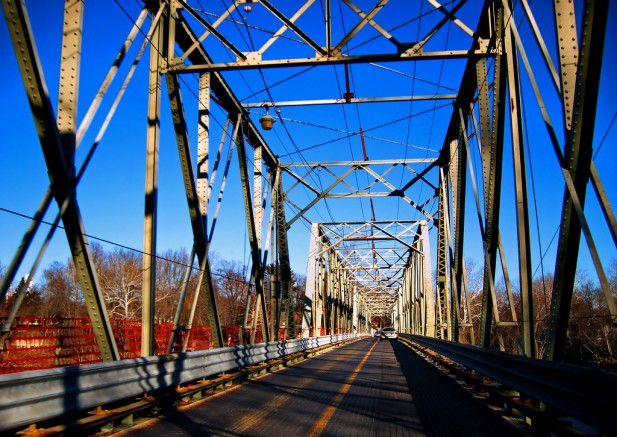The Roads Home
Tom Swick: On a bi-coastal life amid the bridges of the Delaware River
06.02.10 | 9:43 AM ET
The Pennsylvania side is prettier, with luscious curves and leafy canopies. But New Jersey has more towns that make you want to stretch your legs. The drive along the Delaware River can easily turn into a tour of bridges.
In New Hope I usually take the six-span, steel truss bridge into Lambertville, then drive up to Stockton, by which time I’m already pining for PA so I cross the Delaware again and head up the sylvan Route 32 before crossing the river once more, this time into Frenchtown, where, in the past, I’d stop switching sides and drive north until I arrived in my old hometown of Phillipsburg, home of the Stateliners.
But on this last trip I returned to Pennsylvania because, back in November, my mother had sold the house and moved to an assisted living facility in Nazareth run by Moravians. I hugged the river up to Easton, passed with a shiver my old dentist’s office, and then drove a few miles until I reached the hometown of Mario Andretti.
The drive home has always been a metaphor for my life. When people ask me where I grew up, I say New Jersey, but it would be more accurate to say: “On the Delaware River.” I was born in Pennsylvania (the bigger hospital is in Easton) and then whisked, speechless, across state lines, traversing one of the Delaware’s most beautiful bridges. Growing up, I crossed that bridge countless times to go to church, to music lessons, to the movies, to the dreaded dentist. As a family we drove to Pennsylvania for Phillies games. After high school I went to college outside Philadelphia and came home in the summers to work on the bridges over the Delaware, spending muggy days with feet in two states (and usually in dispirited pursuit of a lawn mower. Though one week I helped blacktop the bridge that had carried me as a newborn). I was bi-coastal—though in a modest, non-continental way—before the term existed.
In today’s mobile world, many people have a difficult time saying where they’re from. They suffer, or benefit, (or both), from rootlessness. I am rooted—I feel it every time I drive along the Delaware—but in two places. (You can’t be rooted in a river unless you’re a boat captain, and the only boats on the Delaware north of Trenton are kayaks and canoes.) It’s a condition shared by lots of people who live along rivers—like the Ohio and the Mississippi—that double as borders. (I am always surprised, especially in Europe, by how many rivers don’t serve as borders.)
I can’t say that an early and easy passage between jurisdictions contributed to my becoming a travel writer, since my two older brothers have little interest in travel and even less in writing (and still live in New Jersey). Though for a brief, forgettable period in the late ’80s it did make me a poor editorial writer, as I could always see clearly both sides of every issue.
On the last evening of my visit, my mother and I went to have dinner with one of my brothers in Lebanon. We left early, driving east on Route 22 and passing in view of Easton Hospital. After crossing the toll bridge into New Jersey we took a detour, looping around to the cemetery behind Phillipsburg High School. There on a hill rising up from the river my mother pulled weeds from my father’s grave.![]()
 Bridge linking Riverton, PA and Belvidere, NJ. Photo by
Bridge linking Riverton, PA and Belvidere, NJ. Photo by